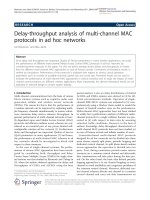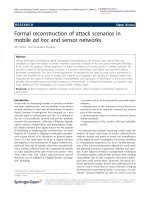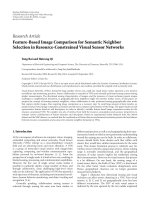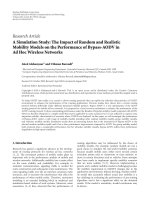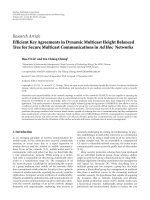Transport layer in ad hoc and sensor networks
Bạn đang xem bản rút gọn của tài liệu. Xem và tải ngay bản đầy đủ của tài liệu tại đây (2.54 MB, 38 trang )
Transport layer in ad hoc and
sensor network
Wireless Ad-Hoc Networking (ELG7178F)
Breeson Francis
Outline
1.
Introduction to TCP
2.
TCP Mechanisms
3.
Problems in TCP
4.
Approaches
5.
References
Transport Layer in ad-hoc and
sensor networks
Introduction to TCP
TCP is a connection based protocol
3 way Hand-shake
TCP is a reliable protocol
achieved by means of retransmissions
TCP enables data to be received in an ordered way
End-to-end semantics
Acknowledgements sent to TCP sender to confirm delivery of data
received by TCP receiver
Ack for data sent only after data has reached receiver
TCP detects data duplication
TCP provides flow and congestion control
Transport Layer in ad-hoc and
sensor networks
Introduction to TCP (ctnd)
TCP Client/Server Connection
Server
Client
TCP SYN
TCP SYN/ACK
TCP ACK
Connection
setup
HTTP request
HTTP response
Data
transmission
HTTP response
FIN
ACK
FIN
ACK
Connection
Termination
Transport Layer in ad-hoc and
sensor networks
TCP Mechanisms
Sliding Window
Offered Window (advertised by receiver)
1
2
3
4
Sent and ack
received
5
6
7
8
9
10 11 12 13 14 15 16 17 18 19 20
Sent, not acked
Usable window
Can’t send until window
moves
Slow Start
Is triggered at the beginning of connection or when a timeout (RTO) occurs
Congestion window (cwnd) is set to 1. cwnd is decided by sender, based on
network conditions
cwnd is increased exponentially
Slow start ends when cwnd reaches ssthresh, congestion avoidance then
onwards
Transport Layer in ad-hoc and sensor
networks
TCP Mechanisms (ctnd)
Congestion Avoidance
Uses congestion window (cwnd) for flow control
Additive increase (at most 1 segment for each RTT)
Multiplicative decrease, cwnd set to 1/2 of its value when
congestion loss occurs
Sender can send up to minimum of advertised window and
cwnd
Congestion
avoidance
Slow start threshold ssthresh = maximum of
Slow start
{ min(cwnd,receiver’s advertised window)/2
and 2 segment size }
Transport Layer in ad-hoc and
sensor networks
TCP Mechanisms (ctnd)
Fast Retransmission and Fast Recovery
Fast retransmit occurs when a packet is lost, but
latter packets get through
When 3 or more dupacks are received, send the
missing segment immediately
Start congestion avoidance (Fast Recovery)
Set cwnd to ssthresh (half the current cwnd)
plus no. of dupacks times segment size
Transport Layer in ad-hoc and
sensor networks
Problems in Wireless Networks
High bit error rate
Packets can be lost due to “noise”
Unpredictability/Variability
Difficult to estimate time-out, RTT, bandwidth
Increased collision due to hidden terminal
Hand-Offs
Mobile users switch base stations
Multipath Routing
Multiple paths lead to significant amount of out-of-order packets,
which in turn generates duplicate acks
Long connections have poor performance
Multi-hop connections have less throughput due to inherent fading
properties of wireless channels
Transport Layer in ad-hoc and
sensor networks
Problems in Wireless Networks
Route Instability
Leads to OOO packets
Transport Layer in ad-hoc and
sensor networks
Problems in Wireless Networks
Network Partitioning
Exponential back off of TCP’s RTO mechanism
RTO doubled after every timeout
Periods of inactivity even when the network is
connected
Transport Layer in ad-hoc and
sensor networks
Problems in Wireless Networks
Bit Error Rate
Packet lost due to high BER
TCP believes that the loss caused by Congestion
-> half the cwnd
-> reduce throughput
Transport Layer in ad-hoc and
sensor networks
Approaches
Link level mechanisms
Split connection approach
TCP-Aware link layer
Explicit notification
Feedback based scheme
Ad-hoc Transport Protocol (ATP)
Transport Layer in ad-hoc and
sensor networks
Approaches
Link level mechanisms
◦ Forward Error Correction (FEC)
Can be used to correct small number of errors
Correctable errors hidden from TCP sender
Applied in situations where retransmissions are
costly or impossible
FEC incurs overhead where there are no errors
Transport Layer in ad-hoc and
sensor networks
Approaches
Link level mechanisms
◦ Link Level Retransmission
Retransmit a packet at link level if error detected
Retransmission overhead incurred only if error
connection
occurs, unlikeTCP
FEC
application
application
application
transport
transport
transport
network
network
link
link
link
physical
physical
physical
FH
BS
rxmt
wireless
network
MH
Transport Layer in ad-hoc and
sensor networks
Approaches
Link level mechanisms
◦ Link Level Retransmission
Hides wireless losses from TCP
Link layer modifications required at both ends of
wireless link
TCP need not be modified, although TCP timeout
should be large enough to accommodate link level
retransmissions
Out of Order (OOO) packet delivery, which may in
turn trigger Fast Retransmit
Transport Layer in ad-hoc and
sensor networks
Approaches
Split Connection Approach
End-to-end TCP connection is broken into wired
part and wireless part
Connection between mobile host (MH) and fixed
host (FH) through base station (BS) is split into
2 TCP connections
Fixed
Host
FH-MH = FH-BS
Wired Network
+
BS-MH
Access
Point
(Base Station)
Mobile
Host
Wireless
TCP Layer in ad-hoc and
Transport
sensor networks
Approaches
Split Connection Approach
Split connection results in independent flow/error
control, packet size, timeouts at each part
Optimized TCP protocol can be introduced in the
wireless segment
TCP connection
TCP connection
application
transport
network
link
physical
FH
application
transport
network
link
physical
BS
rxmt
wireless
application
transport
network
link
physical
MH
Transport Layer in ad-hoc and
sensor networks
Approaches
Split Connection Approach
Loss of end-to-end semantics, an acknowledgement to a sender does not
any longer mean that the intended receiver really got the packet
Higher latency due to buffering at base station
During hand-offs BSs should do state transfer along with the buffers, thereby
increase hand-off latency. BS Failure results in loss of data.
Buffers tend to get full due to slower wireless link
Access
Point (BS1)
Mobile Host
State Transfer
Access
Point (BS2)
Fixed Host
Wired Network
Transport Layer in ad-hoc and
sensor networks
Approaches
Split Connection in multihop wireless network
Many short TCP connections between proxies along the connection
Transport Layer in ad-hoc and
sensor networks
Approaches
Split Connection in multihop wireless
network
Proxies buffer packets from the previous proxy or
the source and acknowledges their receipt with
Local Acknowledgements(LACKs) .
Any dropped packets are recovered from the most
recent proxy but not from the source.
Enhance parallelism. Reduce bandwidth
consumption on retransmission.
Optimal frequency of proxy placement is not clear.
Transport Layer in ad-hoc and
sensor networks
Approaches
TCP Aware Link Layer
Retains local recovery of Split Connection approach and link level
retransmission
Improves on split connection
end-to-end semantics retained
soft state at base station, instead of hard state
TCP connection
application
application
application
transport
transport
transport
network
network
link
link
link
physical
physical
physical
FH
BS
rxmt
network
wireless
Transport
MH
Layer in ad-hoc and
sensor networks
Approaches
TCP Aware Link Layer
Buffers data at BS for link layer retransmission
When dupacks received by BS from MH, retransmit on wireless link,
if present in buffer. Hides wireless losses from sender
Prevents fast retransmit at sender TCP by dropping dupacks at BS
Requires modification at BS only
Link layer at base station needs to be TCP-aware
Not useful if TCP headers are encrypted (IPsec)
Cannot be used if TCP data and TCP acks traverse different paths
(both do not go through the same base station)
Transport Layer in ad-hoc and
sensor networks
Approaches
Explicit Notification
◦ Explicit Loss Notification (MH is TCP Sender)
Wireless link first on the path from sender to receiver
The base station keeps track of holes in the packet sequence
received from the sender
When a dupack is received from the receiver, the base station
compares the dupack sequence number with the recorded holes, an
ELN bit is set in the dupack
When sender receives dupack with ELN set, it retransmits packet, but
does not reduce congestion window
Record
hole at 2
MH
4
wireless
3
2
1
1
BS
1
Dupack with ELN set
4
3
1
1
FH
1
Transport Layer in ad-hoc and
sensor networks
Approaches
Explicit Notification
◦ Explicit Loss Notification (MH is TCP Receiver)
Caches TCP sequence numbers at base station, similar to
Snoop. But does not cache data packets, unlike Snoop.
Duplicate acks are tagged with ELN bit before being forwarded
to sender if sequence number for the lost packet is cached at
the base station
Sequence numbers
cached at base station
39
38
37
FH
BS
37
39
38
37
MH
37
Dupack with ELN
Transport Layer in ad-hoc and
sensor networks
Approaches
Feedback based scheme in multihop wireless network
Intermediate MH detects mobility of next MH along the path to
destination
Triggers Route Failure Notification(RFN) to source
Each intermediate MH validates RFN and propagates to the source
On receiving RFN, source
Stops sending further packets
Freezes all its timers
Stores Window size and packets to be sent
S
B
RF
N
A
RFN
C
D
Transport Layer in ad-hoc and
sensor networks





